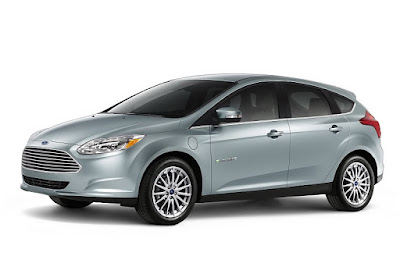Like Toyota did when it made the first Prius hybrid, Nissan and Chevy chose to invent new names and shapes for their EVs. Ford is taking a different approach with the 2012 Focus Electric, the company’s first all-electric passenger car. Introduced at the Consumer Electronics Show in Las Vegas, the Focus Electric is based on a regular, soon-to-be-familiar, high-volume production car.
Ford seems less concerned with differentiating the Focus Electric from internal-combustion Focus models than it does with beating its competitors for EV bragging rights—even as, it should be noted, those competitors will have beat it to the electric-car market by about a year. The Focus Electric will arrive here at the end of 2011 and will spread internationally a year later.
The Electric’s guts include a 123-hp electric motor that makes 181 lb-ft of torque from 0 rpm—less horsepower but more torque than the 155-hp, 140-lb-ft, 2.0-liter four in the conventional 2012 Focus. The electric car’s single-speed transmission allows for a top speed of 84 mph.
A total of 23 kWh of energy is stored in a battery pack located under and behind the rear seat. The pack is comprised of cells sourced from LG Chem and assembled by a supplier in Michigan. The EV powertrain is installed in the same Wayne, Michigan, plant that assembles non-EV North American Focus models. Aside from the lack of shifting, quieter operation, and additional weight (Ford quotes a curb weight of 3691 pounds, or about 700 pounds heavier than a gas-powered five-door), the company says that the experience will be like that offered by a regular Focus. Since adding that much weight seriously affects ride and handling, what Ford really means is that it will offer the same options in the same five-door wrapper.
Ford expects the Focus Electric to have a better miles-per-gallon-equivalent rating than the Chevrolet Volt’s 93 MPGe, and one comparable to those of other all-electric cars—we assume that refers to the Nissan Leaf, which scores a 99. The Focus Electric’s battery is about the same size as the Leaf’s, which, based on our experience, should be good for about 70 miles on a charge. The Focus’s additional mass means its range will be a bit lower.
Charge time on 240-volt power is pegged at three to four hours, or about half that needed by the Leaf; this is accomplished through the fitment of an on-board charger that is twice as powerful as the Nissan’s: 6.6 kW versus the Leaf’s 3.3. A charge on 120-volt household current will take somewhere between 18 and 20 hours, or about the same as a Leaf. This is because either charger is limited by the amount of juice available from a 120-volt circuit, whereas the Ford charger can better exploit the higher limits of a 240-volt system. Ford will include a 120-volt cord with the Focus, and a Ford-branded 240-volt home charger will be available through Best Buy for approximately $1500, including installation. A “value charging” function times recharging to coincide with the lowest energy rates.


 11:37 AM
11:37 AM
 Admin
Admin

 Posted in:
Posted in: 



